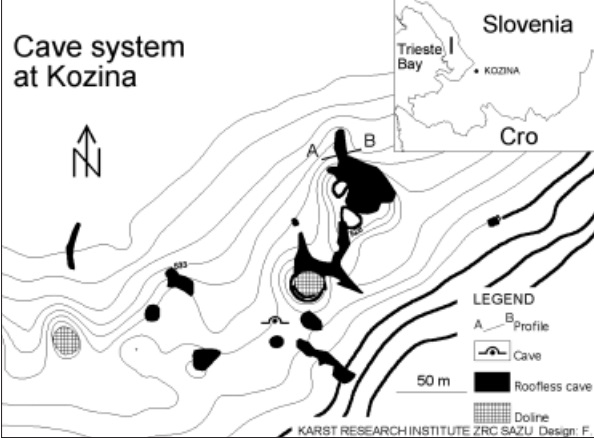Palaeomagnetic Research of a Fossil Cave in the Highway Construction at Kozina, SW Slovenia
DOI:
https://doi.org/10.3986/ac.v29i2.446Abstract
Jama brez stropa je bila zapolnjena s peščenimi naplavinami dinamične strukture ter teksture svetlo rjave in oker barve. Na vrhu 5 m debelega prereza naplavin so bile rjava prst in skale. Pobranih je bilo 38 vzorcev naplavin. Posamezne magnetne cone nakazujejo, da je naplavina starejša od zgornjega Olduvaja (1,77 M); kot kozinski prerez se konča z reverzno polarizirano magnetno cono in ima dve normalni polarizirani coni. Prerez naplavin je podoben divaškemu. Predvidevamo, da je jama iz mesinskega obdobja in da so naplavine v njej posledica hitrega zvišanja gladine podzemeljske vode po ponovni zapolnitvi mediteranskega bazena z vodo, torej da so bile odložene pred 5,2 milijoni let.
A fossil channel was filled by sandy sediments of light brown to ochreous color with dynamic structures and textures (lower sequence) unconformably overlain by remains of collapsed roof with brown and ochreous matrix (upper sequence). The sedimentary profile was about 5 m high. In all 38 samples taken from the profile, only one was cemented. Samples were demagnetised by alternating field (AF) at 10 to 1,000 Oe. The cemented one was demagnetised by gradual thermal process from 80 to 560 °C in the MAVACS apparatus. Detected remanent magnetisation in a natural state varied between 95 and 36,470 pT, values of volume magnetic susceptibility are from 55 to 998 x 10-6 SI. Rocks showed low or medium magnetisation. Normal and inverse polarization was detected after demagnetisation. The primary component of magnetisation and resulting polarity could not be stated in samples with expressive viscose component (up to 90 %). According to arrangement of individual magnetozone, it can be stated that sediments are older than the top of Olduvai chron (1.77 Ma), as the magnetostratigraphic profile at Kozina terminated by reverse polarised magnetozone and contains two normal polarised zones. The profile can be correlated with the Divača profile, not only from the palaeomagnetic point of view, but also from a lithological point of view. We suppose, as in Divača, that the cave is a result of the Messinian speleogenetic epoch and its fossilization was connected with rapid base level uplift after refilling of the Mediterranean basin by water. If this hypothesis is close to reality, the fossilization process can be dated from about 5.2 Ma up.
Downloads

Downloads
Published
How to Cite
Issue
Section
License
Authors guarantee that the work is their own original creation and does not infringe any statutory or common-law copyright or any proprietary right of any third party. In case of claims by third parties, authors commit their self to defend the interests of the publisher, and shall cover any potential costs.
More in: Submission chapter




